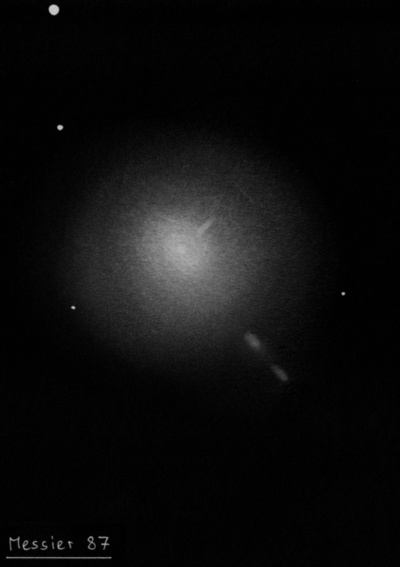Virgo Galaxy
Virgo Galaxy

Charles Messier is credited with the discovery of M87 = NGC 4486 = h1301 on 18 Mar 1781. But Wolfgang Steinicke recently found (email Oct '16) that Johann Gottfried Koehler made the original discovery on 5 May 1779. On 17 Apr 1784 (sweep 199), WH logged "Three nebulae, the two first [NGC 4476 and 4478] vF, S, the third [M87], B, L, mbM but diminishing very gradually in brightness." JH made at least 5 observations, recording on sweep 245, "vB; vL; R; psmbM; r; 3' diam."
M87 is one of the most distant galaxies (~52 million light years) visible in binoculars. It contains a 6.4-billion-solar-mass black hole (1,000 times more massive than Sgr A). The 20" jet was discovered by Heber Curtis at Lick Observatory in 1918 and described as a "curious straight ray lies in a gap in the nebulosity in pa 20°, apparently connected with the nucleus by a thin line of matter. The ray is brightest at the inner end, which is 11" from the nucleus."
A supernova (1919A) was found in 1922 by Russian astronomer Balnowski on a plate taken 24 Feb 1919.
300/350mm - 13.1" (5/14/83): very bright, intense core, fairly smooth halo.
400/500mm - 17.5" (5/23/87): very bright, fairly large, gradually increases to a very bright core, no sharp nucleus. A very compact galaxy NGC 4486A = UGC 7658 lies 7' S.
600/800mm - 24" (5/29/14): extremely bright, large, slightly elongated NNW-SSE, ~4'x3.5', well concentrated with a large, intense core. The core brightens but there was no distinct nucleus. The halo gradually fades and increases in size with averted vision. Several galaxies are nearby including NGC 4486B 7.2' NW, NGC 4486A 7.6' SSE, NGC 4478 8.7' SW and NGC 4476 12.6' WSW.
900/1200mm - 48" (5/4/16 and 4/30/19): at 488x, 610x and 697x; M87's jet was almost continuously visible as a small, very thin spike extending to the west-northwest of the core, perhaps 15"x2". When the seeing was sharp, there was a brighter, knot (stellar) at the outer tip that sometimes appeared detached. There was a strong impression of a second stellar knot within the spike.
48" (4/1/11): at 488x, the jet in M87 was immediately noticed as a short, faint spike poking out of the central core to the WNW and the position angle [290-300°] was accurately sketched without prior knowledge. The narrow jet brightened or there was a knot at the outer tip.
In addition to looking for the jet, I sketched three companions at the edge of the outer halo on the southwest side. About 2' SW of the center of M87 is a pair of very faint, roundish galaxies, both ~15" diameter. The pair forms UGC 7652 with the components separated by 40" and nearly aligned with the center of the galaxy as if they were ejected. 2MASX J12303903+1222222, an extremely faint companion (V = 17.9), lies 2.8' WSW of the core, just 20" SE of a mag 15.5 star. The three close "companions" to M87 are actually part of a distant, poor cluster in the background of M87, with a redshift of 20x that of M87!
Virgo UCD 3 is either one of the brightest globular clusters in M87 or a nucleated dwarf galaxy, called a Ultra-Compact Dwarf (UCD). It is situated just 3.0' NE of the center of M87, directly opposite the two small galaxies at the southwest edge of the halo of M87. A mag 14.5 star, just 20" SSW, is a perfect reference to focus on the cluster. On 4/16/13 using 488x it was suspected as an 18th magnitude "star", but I didn't feel confident of the observation. At 813x, though, it was confirmed as an extremely faint, stellar object, glimpsed several times at the same position.
Notes by Steve Gottlieb